Yoshihiko Matsui’s Films about Outsiders and Twisted Love 松井良彦
Yoshihiko Matsui, the underground Japanese movie director, is known for his movies Noisy Requiem and Where Are We Going? (Doko ni Iku no, 2008).
For Japanese independent cinema, the 1980s were an incredibly wild and energetic decade. A new generation of filmmakers took over and replaced the faded student revolution-inspired movies of the 1960s and 70s with high-speed, high-octane biker and punk flicks.
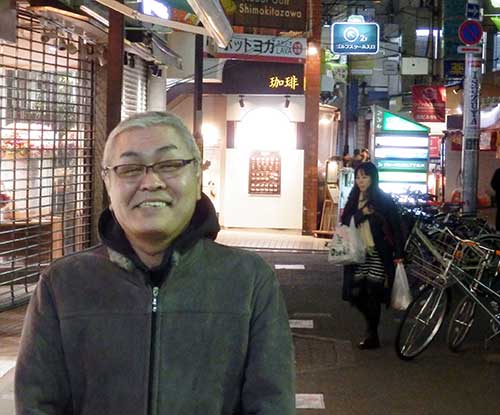
Sogo Ishii’s Crazy Thunder Road, released in 1980, loudly and aggressively announced the arrival of the punk generation. Extremely violent biker battles, a punk rock sound track and rapid-fire editing, the film had it all and served thus as blueprint for things to come.
In fact, Crazy Thunder Road was the 16mm lensed film school graduation picture of then 23-year-old Ishii but the distribution arm of major Toei Studio picked up the pic and threw it onto movie screens all over the country.
To give a short impression of the movie, and with it, sort of an introduction to the spirit of the decade, here’s the trailer for Crazy Thunder Road.
Numerous other aspiring directors of Ishii’s generation took up the challenge, reasoning “what Ishii can do, I also can do” and soon got to work on their own pictures.
Masashi Yamamoto’s dark and nihilistic Shinjuku underground epic Carnival in the Night (1982) for example was a sort of direct answer to Crazy Thunder Road.
Through the decade, Ishii sped up things even more with his punk rock madness flick Burst City (1982) which eventually inspired the cyberpunk explosion started by Shinya Tsukamoto’s Tetsuo – the Iron Man (1989), closely followed up by the high speed brain drillers of Shozin Fukui.
Yoshihiko Matsui: The Early Works
Yoshihiko Matsui must have been the quiet kid in a movie maker crowd searching for the ultimate amplification of noise and speed.
Born in Nishinomiya, Hyogo Prefecture in 1956, Matsui was present right at the start of Sogo Ishii’s activism. Matsui was a founding member of Kyoeisha, a filmmaker’s group initiated by Ishii in 1975. Matsui worked as assistant director on Ishii’s first exploits, namely Panic in High School (1976), he was also Ishii’s co-editor on Crazy Thunder Road and in that capacity, certainly helped to speed up the film.
His own films however are markedly different. They are slow, heavy and aiming for the profound. Matsui took the energy of the era into a totally new direction. His films are all about social outcasts and, as he often said in interviews, “all about love”. Just that the love relations between the outcasts he depicts tend to end in a swirl of violence and self-destruction.
Sogo Ishii himself was the director of photography for Matsui’s first own cinematic effort Rusty Empty Can (Sabita Kankara, 1979).
The one-hour movie tells the story of a tragic gay love-triangle. Long-haired and very feminine Akira is in an uneasy relationship with a violent thug. A somewhat awkward loner has a chance encounter with Akira and instantly falls in love with him. Akira himself seems to be open to the advances of the loner, his thug boyfriend however quickly finds out that there is another man trying to undermine his relationship with Akira and repeatedly beats up the loner. This, in turn, angers Akira who eventually sinks his teeth deeply into the thug’s most precious piece during a final sex act. There is no happy end. The thug crawls on a toilet floor, covered in blood. Akira runs madly through the streets. For the loner, all is lost.
All shot in color 8mm, the film conveys the feeling of a Warhol-era underground movie while at the same time, it could also be seen as a sort of early artistic gay pink movie with its prolonged but never explicit gay sex scenes.
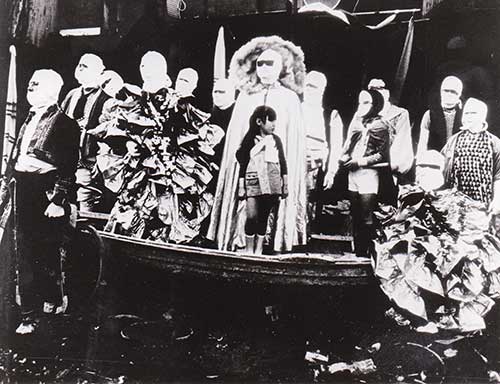
In his follow-up Pig-Chicken-Suicide (Tonkei Shinju, 1981) Matsui tells a story of failed love between two Korean residents in Japan. The main character in the story, again named Akira, works at a big chicken processing plant. He positively indentifies as chicken himself, wearing a beak over his mouth and dancing like a chicken – among the chickens in their cages. He falls in love with a girl named Sachiko but she prefers to masturbate to Emperor Hirohito’s surrender speech ending World War II over answering to Chicken-Akira’s advances.
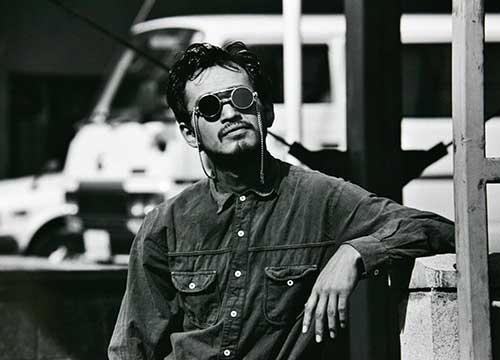
Noisy Requiem
The film that eventually turned Matsui into one of Japan’s most respected cult directors was his third, Noisy Requiem (Tsuito no Zawameki, 1988).
The film is entirely set in the Shinsekai neighborhood of Osaka, an area that feels like a remnant of Japan in the distant past. Though partly very touristy today, Shinsekai and especially the neighboring Tobita district harbor plenty of pockets of poverty, unseen in any other parts of the country.
The low rent and anonymity in parts of Shinsekai make the area also a refuge of outcasts of every stripe who can go freely about their business there in ways that wouldn’t be accepted anywhere else in Japan.
I wrote a description of Noisy Requiem for Midnight Eye, a site specializing in Japanese cinema, a few years ago. Since I think that that description is still valid today, I quote here the central part:
“The black and white movie opens with a freeze-frame of the main character Makoto (played by pink movie director Kazuhiro Sano) walking straight through the homeless ghetto of Kamagasaki. The freeze-frame springs to life, and he walks absent-mindedly towards the camera. Cut to him feeding pigeons in a park, then taking out a claw-hammer and killing a bunch of them. Whistling, he lays down on a park bench and rips the heads off the dead birds. Shots of ghastly homeless shuffling through Kamagasaki, shots of Makoto killing women in dirty backlots next to busy railway lines, cutting organs out of their bellies and stuffing them into a garbage bag. Makoto and a mannequin doll on the rooftop of the abandoned warehouse where he lives. He cuts the mannequin a vagina and stuffs the bloody entrails of the murdered women in there.
We are still right at the beginning of the movie at this point, and not a line of dialog has been spoken. The first spoken lines come from two uniformed schoolgirls who wander through the park where Makoto has killed the pigeons.
While they sit down near two blind war veteran buskers, one of them tells her previous night’s dream to the other. There was a boy feeding pigeons, she says, and there was one white pigeon that couldn’t get any of the grain because the many other grey pigeons constantly got in its way. So, the white pigeon turned black … it became a crow. Suddenly the scenery changed, she explains, crows fed on thousands of dead people. The white pigeon that had turned into a crow joins in. The girl walks over to the buskers and gives them some money, then continuing: “Everybody turns into a crow when they’re hungry.”
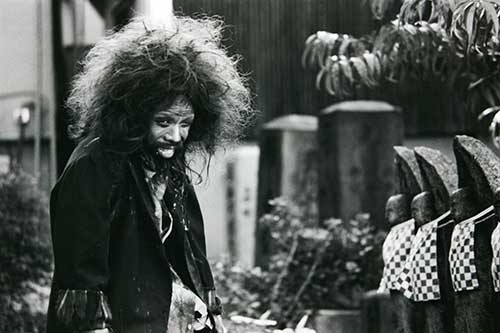
Now, this is the key line of the movie. All characters in the film are desperately hungry for something humane: mainly for love but for some characters a little bit of tender attention or at least some basic form of acceptance will do. Being constantly denied any of this, they all turn into vicious crows. Or rather, extremely troubled humans. Shortly after the girls leave, Makoto enters the scene. He insults the busking war veterans and questions the war credits they claim, accusing them of being “lazy Koreans” who “did nothing during the war”. He gets his claw hammer out and … well, I’m not going to describe the scene. You’ve got to watch it. Interesting thing is, though, that Makoto comes off at that moment as an extreme Korean-hating fanatic. In fact, later moments in the movie suggest that he is more likely a closet Korean himself.
The plot continues with Makoto getting a job as an underground sewage line cleaner, working for an incestuous brother-sister midget couple. He is wildly in love with the mannequin he has stuffed with the organs of the women he had killed – in order to give it the means to bear his child. A crazy, sex-starved bum (played by Butoh dancer Isamu Osuga) who tries to take advantage of the same mannequin when Makoto is not around will meet a gruesome fate in a particularly memorable scene.
In short, virtually everybody who shows up in the movie has already reached the end of the line in some respect at the point at which they are introduced… they had already been transformed from the virgin white dove to the black crow. But from the moment they appear, things get invariably worse for all of them. Death is the only way out and death doesn’t come easily in this film.
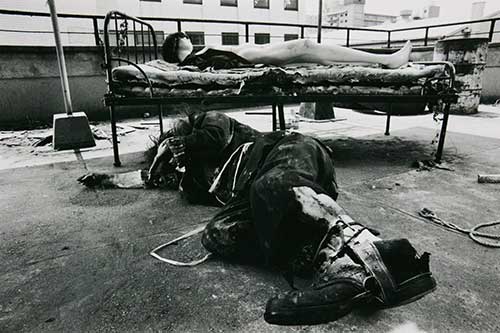
Add to that the rough guerrilla street-level b&w photography done right in the midst of the Kamagasaki homeless area and a cast that includes a host of truly bizarre characters played by unknown but terribly convincing actors and you got a movie that looks like its emerged straight out of hell. And with guerrilla film making I mean guerrilla film making: I don’t know about any other Japanese filmmaker who would have a character of his film setting the entire rooftop of an abandoned building right in the middle of the city on fire, obviously without any permission, film it from a neighboring rooftop, then sneak back and shoot the unsuspecting firefighters as they are dealing with the inferno.”
It took Matsui five years to shoot the film, from 1983 to 1988. After finishing the feature, finding a venue to open the film proved to be another tough task.
Two-and-a-half hours of slow-paced misfit perversion seemed to be too daunting to even the most intrepid independent movie theater operators. One theater manager after another turned Matsui down.
Matsui had spent five years producing and directing the film and he was not going to give up. When he finally dialed the number of the Nakano Musashino Hall Theater in Tokyo, he eventually received a “yes, let’s try.”
The, by now sadly missed, Nakano Musashino Hall was always open to experiments no one else would dare. To everyone’s surprise, the shows turned into an outstanding success, not only at the immediate box office but establishing Noisy Requiem as a long-term cult movie.
The film is still getting occasionally booked by the ever-shrinking circuit of Japanese independent theaters catering to offbeat audiences. With a bit of patience, catching a show shouldn’t be too much of a problem for any resident of Tokyo or Kansai even today.
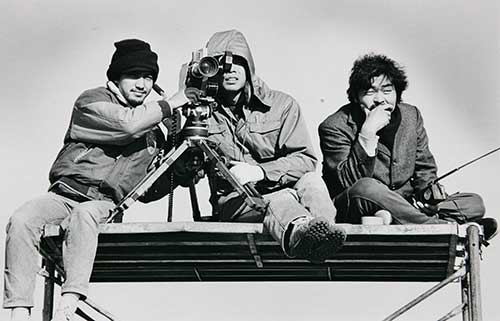
On DVD, the film is currently only available in Japanese.
If you search torrent sites on the net, however, it is not very difficult to find fan-subbed copies of the film. Matsui himself seems to tacitly approve of those pirate copies for the time being. After all, they give the film a certain exposure to international audiences.
Where Are We Going?
Despite Noisy Requiem’s box office success in Japan, it proved to be hard for Matsui to find funding for a new project. In fact, it took him 20 years until he was able to premiere his next film, Where Are We Going? (Doko ni Iku no, 2008).
Where Are We Going? tells the story of Akira, an orphan working as a mechanic at a small metal workshop. His horny boss is constantly sexually abusing Akira but Akira has no way to escape his situation. Riding his motorbike is his only relief.
One day, he has a minor accident, hitting a lady with his bike. The lady turns out to be a transvestite and the two soon fall in love. It wouldn’t be a Matsui film if things wouldn’t down spiral soon.
Though Where Are We Going? was only a modest success in Japan, it played at quite a few international film festivals. Matsui was especially proud attending the Moscow Film Festival where his movie was shown on the same screen that had seen the premiere of Akira Kurosawa’s Dersu Uzala (1975), Kurosawa’s Soviet-produced masterpiece.
Matsui’s work is often labeled “underground” by international critics but Matsui himself insists that he makes “real movies”. Just like Kurosawa, like Federico Fellini or Pier Paolo Pasolini. Nobody calls the sometimes controversial work of those directors “underground”. Why insist critics calling his films “underground” then, he often muses when you talk to him in person.
When I sat down with Matsui recently over a steaming hot bowl of soba noodles, he told me about his newest project. A big-budget project he has been working on for quite a few years by now. He swore me in on absolute secrecy. So, all I can say is – keep your eyes open. In a year or two, a rather large-scale Matsui movie will hit the screens.
Recently, Matsui gave a long interview spanning the details of his whole career to British writer Matthew Edwards. The interview is part of Edward’s upcoming book (May 2017) Twisted Visions: Interviews with Cult Horror Filmmakers.
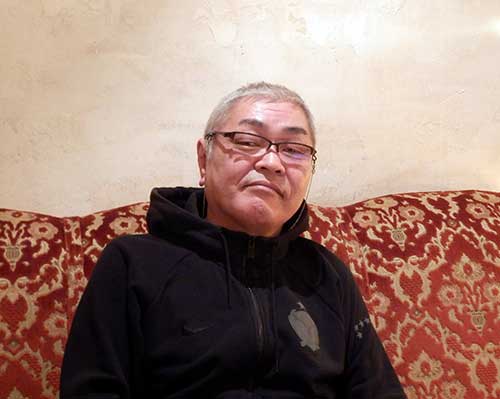
Talking with Matsui about the book, he just chuckled about the title. “I’m not a horror filmmaker.” he said. “My films are all about love.”
Johannes Schonherr